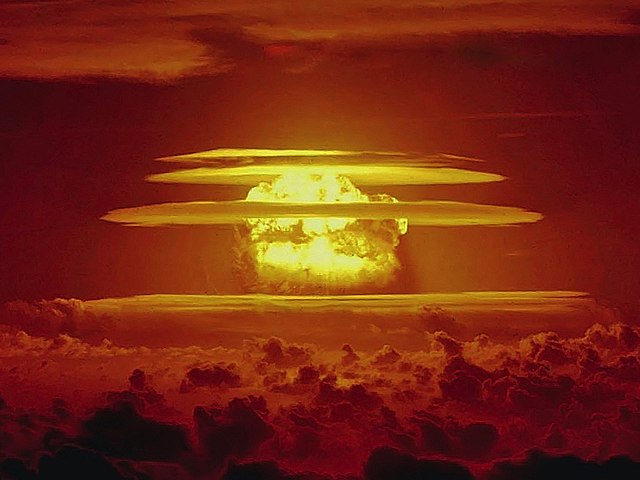British nuclear tests at Maralinga
Between 1956 and 1963, the United Kingdom conducted seven nuclear tests at the Maralinga site in South Australia, part of the Woomera Prohibited Area about 800 kilometres (500 mi) north west of Adelaide. Two major test series were conducted: Operation Buffalo in 1956 and Operation Antler the following year. Approximate weapon yields ranged from 1 to 27 kilotons of TNT. The Maralinga site was also used for minor trials, tests of nuclear weapons components not involving nuclear explosions. Kittens were trials of neutron initiators; Rats and Tims measured how the fissile core of a nuclear weapon was compressed by the high explosive shock wave; and Vixens investigated the effects of fire or non-nuclear explosions on atomic weapons. The minor trials, numbering around 550, ultimately generated far more contamination than the major tests.
Buffalo R4/Breakaway nuclear test
The United Kingdom Minister of Defence, Duncan Sandys (centre) meets with Howard Beale (right), the Australian Minister for Supply in August 1957.
Emu-Ooldea-Tietkens Well reconnaissance
Cutting a temporary access road from Watson to Tietkens Well
Nuclear weapons tests are experiments carried out to determine the performance, yield, and effects of nuclear weapons. Testing nuclear weapons offers practical information about how the weapons function, how detonations are affected by different conditions, and how personnel, structures, and equipment are affected when subjected to nuclear explosions. However, nuclear testing has often been used as an indicator of scientific and military strength. Many tests have been overtly political in their intention; most nuclear weapons states publicly declared their nuclear status through a nuclear test.
The mushroom cloud from the Castle Bravo thermonuclear weapon test in 1954, the largest nuclear weapons test ever conducted by the United States
Subcritical experiment at the Nevada National Security Site
The Phoenix of Hiroshima (foreground) in Hong Kong Harbor in 1967, was involved in several famous anti-nuclear protest voyages against nuclear testing in the Pacific.
The first atomic test, "Trinity", took place on July 16, 1945.








